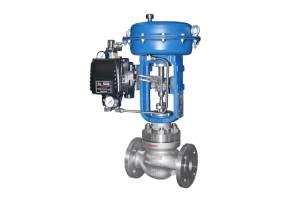Jun. 28, 2020
What is the structure of the control valve?
The regulating valve is generally composed of two parts: the actuator and the valve assembly. In some occasions, accessories such as valve positioners and handwheel mechanisms may be provided.
Different classification of regulating valve
The control valves are classified according to driving energy, uses and functions, special uses (ie special, special valves), pressure, medium working temperature, structure, etc.
Common taxonomy:
➊Single seated regulating valve
❷Double seat regulating valve
❸ Sleeve regulating valve
❹Angle shaped regulating valve
❺Three-way regulating valve
❻ Diaphragm valve
❼ Butterfly valve
❸Ball valve
❾Eccentric rotary valve

Single Seated Regulating Valve
notes
This classification method is divided by principle, function, and structure. It is the most commonly used classification method at home and abroad. Generally divided into nine categories, the first 6 types are straight travel, the last 3 types are angular travel.
These nine products are also the most basic products, also known as ordinary products, basic products, or standard products. Various special products and special products are improved and modified on the basis of these nine types of products.
There are two types of straight travel: straight-through single-seat type and straight-through double-seat type. The latter has the characteristics of large circulation capacity, small unbalanced operation, and stable operation, so it is usually particularly suitable for occasions with large flow, high-pressure drop, and low leakage.
Driving energy
❷Electric control valve
❸Hydraulic regulating valve
PK
notes
The differences between the three are as follows:
[Pneumatic valve]: a valve driven by compressed air. Working principle: The pneumatic regulating valve is composed of the actuator and regulating mechanism. The actuator is the thrust component of the regulating valve. It generates the corresponding thrust according to the magnitude of the control signal pressure and pushes the regulating mechanism to act. The valve body is the regulating component of the pneumatic regulating valve. It directly contacts the regulating medium to regulate the flow of the fluid.
[Hydraulic valve]: A valve driven by the pressure of oil and other liquids. Working principle hydraulic valve directional control valve pressure control valve flow control valve directional control valve controls the direction of oil flow in the hydraulic system or the on and off of the liquid flow check valve reversing valve bidirectional hydraulic lock check valve The working principle of the valve uses the relative movement of the spool and the valve body to make the oil circuit switch on, off or change the direction of the oil flow, so as to realize the start, stop or change the direction of movement of the hydraulic actuator and its driving mechanism.
[Electric valve]: Control the valve with an electric actuator, so as to realize the opening and closing of the valve. It can be divided into upper and lower parts, the upper half is an electric actuator, and the lower half is a valve. Also called air conditioner valve. Electric valves are usually connected by electric actuators and valves, and become electric valves after installation and debugging. The electric valve uses electric energy as the power to connect the electric actuator to drive the valve, and realize the switching and regulating action of the valve. So as to achieve the purpose of switching or adjusting the pipeline medium.
Headquarter Add.: SUPCON Park, No.309 Liuhe Road, Binjiang District, Hangzhou, 310053, China.
Tel.: +86 571 8111 9774
Fax: +86 571 8111 9737
E-mail: [email protected]
